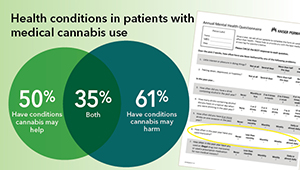Medication Use & Patient Safety
Research overview
Americans are using more prescription drugs than ever. Consequently, they’re coping with more side effects, drug interactions, and costs, especially if they’re using multiple medications. Kaiser Permanente Washington Health Research Institute (KPWHRI) scientists are on the forefront of answering questions about these concerns. We’re studying the beneficial and harmful effects of medications in real-world settings, and innovating better ways to manage and monitor drug use.
The institute contributes to national initiatives to monitor medication safety as well as providing information to help doctors and patients weigh the risks and benefits of various prescription drugs.
Funders of KPWHRI medication use and patient safety research include the Centers for Disease Control and Prevention, the U.S. Food and Drug Administration, the National Institutes of Health, the Patient-Centered Outcomes Research Institute, and other sources. A few projects include:
- Studying whether commonly used medications, including oral contraceptives, are associated with the risk of developing COVID-19 infection or severe disease
- Exploring patient and clinical risk factors for opioid misuse, abuse, and addiction
- Evaluating an intervention for patients taking long-term high-dose opioids to successfully taper their use without negatively impacting pain management and quality of life
- Proactive monitoring of medical products through the FDA Sentinel Initiative
- Studying medication safety for pregnant people and older adults
- Monitoring vaccine safety and effectiveness
- Investigating how medications affect risk of cognitive decline and dementia in late life
- Reaching out to inform patients and providers about the risks of, and alternatives to, commonly used medications that may contribute to falls, including over-the-counter antihistamines
Recent publications on Medication Use & Patient Safety
Rossom RC, Shortreed S, Coleman KJ, Beck A, Waitzfelder BE, Stewart C, Ahmedani BK, Zeber JE, Simon GE. Antidepressant adherence across diverse populations and healthcare settings. Depress Anxiety. 2016 Jun 20. doi: 10.1002/da.22532. [Epub ahead of print]. PubMed
Calip GS, Yu O, Elmore JG, Boudreau DM. Comparative safety of diabetes medications and risk of incident invasive breast cancer: a population-based cohort study. Cancer Causes Control. 2016;27(5):709-20. doi: 10.1007/s10552-016-0744-3. Epub 2016 Apr 6. PubMed
Von Korff MR, Franklin G. Responding to America's iatrogenic epidemic of prescription opioid addiction and overdose. Med Care. 2016;54(5):426-9. doi: 10.1097/MLR.0000000000000537. PubMed
Turner JA, Shortreed SM, Saunders KW, LeResche L, Von Korff M. Association of levels of opioid use with pain and activity interference among patients initiating chronic opioid therapy: a longitudinal study. Pain. 2016 Apr;157(4):849-57. doi: 10.1097/j.pain.0000000000000452. PubMed
Gray SL, Dublin S, Yu O, Walker RL, Anderson ML, Hubbard R, Crane PK, Larson EB. Benzodiazepine use and risk of incident dementia or cognitive decline: prospective population based study. BMJ. 2016 Feb 2;352:i90. doi: 10.1136/bmj.i90. PubMed
Researchers in Medication Use & Patient Safety
 Sascha Dublin, MD, PhDSenior Investigator |
 Jessica Chubak, PhDSenior Investigator |
 Andrea J. Cook, PhDSenior Biostatistics Investigator |
 Rita Mangione-Smith, MD, MPHExecutive Director and Senior Investigator, KPWHRI; Vice President for Research and Health Care Innovation, Kaiser Permanente Washington |
 Jennifer C. Nelson, PhDDirector, Biostatistics; Senior Investigator |
 David E. Arterburn, MD, MPHSenior Investigator |
 Susan M. Shortreed, PhDSenior Biostatistics Investigator |
 Lisa A. Jackson, MD, MPHSenior Investigator |
 Karen Wernli, PhDSenior Investigator |
 Onchee Yu, MSPrincipal Collaborative Biostatistician |
 Rod L. Walker, MSPrincipal Collaborative Biostatistician |
 Robert D. Wellman, MSPrincipal Collaborative Biostatistician |
 Gaia Pocobelli, PhDSenior Collaborative Scientist |
 Laura Harrington, PhD, MPHAssociate Investigator |
 Jennifer F. Bobb, PhDAssociate Biostatistics Investigator |
 Weiwei Zhu, MSSenior Collaborative Biostatistician |
 Paige D. Wartko, PhD, MPHSenior Collaborative Scientist |
 Maricela Cruz, PhDAssistant Biostatistics Investigator |
 Brian D. Williamson, PhDAssistant Biostatistics Investigator |
 Noorie Hyun, PhDAssociate Biostatistics Investigator |
 Laurel Hansell, MA, MPHCollaborative Scientist |
 Jess Mogk, MPHCollaborative Scientist |
Affiliate researchers
Susan Heckbert, MD, PhD
University of Washington (UW) Department of Epidemiology; UW Cardiovascular Health Research Unit
David Siscovick, MD, MPH
UW Department of Medicine; UW Department of Epidemiology; UW Cardiovascular Health Research Unit
Leslie Spangler, PhD
Amgen















